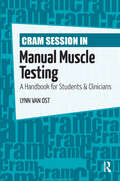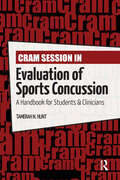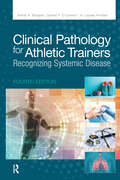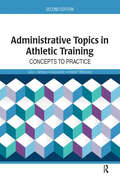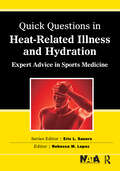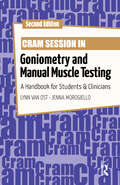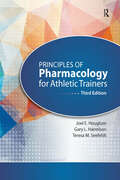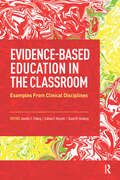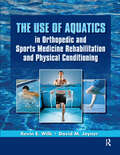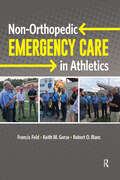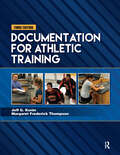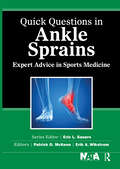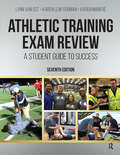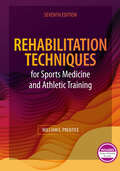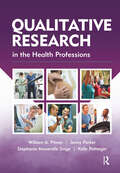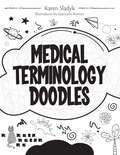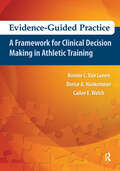- Table View
- List View
An Athletic Trainers’ Guide to Sports Nutrition
by Damon AmatoAn Athletic Trainer’s Guide to Sports Nutrition fills the void of a subject area that is underrepresented in current athletic trainer curriculums despite its importance in the field. Damon Amato has created a text that can be easily read and understood by health care professionals yet is in-depth enough to create a solid understanding of how the body works, and easy enough to then pass on the information to athletes to help them eat ideally based on their specific sport, goal, and situation. Giving a physiology background is necessary to lay the foundation for understanding why certain recommendations in the text are given; however, only the necessary details are included to focus on what is pertinent for athletic trainers to understand while advising athletes.Some topics covered inside include: Basics of human nutrition Disordered eating and eating disorders in athletes Supplements Eating optimally for injury recovery Nutrient timing Special situations An Athletic Trainer’s Guide to Sports Nutrition gives athletic training clinicians and students the information and tools necessary to aid athletes in maintaining peak performance in nutrition, and fills the void left in the current athletic training curriculum.
Cram Session in Manual Muscle Testing: A Handbook for Students and Clinicians
by Lynn Van OstWhen all you need is a basic understanding of manual muscle testing. When concise and illustrative examples of manual muscle testing techniques will provide exactly what the rehabilitation professional needs, look to Cram Session in Manual Muscle Testing: A Handbook for Students & Clinicians for quick and “at your fingertips” facts.Cram Session in Manual Muscle Testing: A Handbook for Students & Clinicians by Lynn Van Ost is a succinct and descriptive quick reference that provides the rehabilitation professional with a very basic approach to various manual muscle techniques. Organized in a “head to toe” format, Cram Session in Manual Muscle Testing: A Handbook for Students & Clinicians takes user-friendly and efficient learning to a new level.What is in your “Cram Session”:• Photographs depicting each manual muscle testing technique• Breakdown of each body region covered• Sections include average range of motion, prime movers, accessory muscles, patient positioning, muscle grading for each movement and substitutions• Over 200 photographsCram Session in Manual Muscle Testing: A Handbook for Students & Clinicians is an informative, well-organized handbook for all students and clinicians in physical therapy, occupational therapy, athletic training, orthopedics or any allied health professional who treats musculoskeletal disorders
Cram Session in Evaluation of Sports Concussion: A Handbook for Students & Clinicians
by Tamerah HuntWhen you need a fundamental and clinical understanding of sports concussions, supplemented by current research and management techniques, look to Cram Session in Evaluation of Sports Concussion: A Handbook for Students & Clinicians for quick and at-your-fingertips facts.Cram Session in Evaluation of Sports Concussion: A Handbook for Students & Clinicians by Dr. Tamerah N. Hunt is a succinct and descriptive quick reference that provides the health care professional with a simple step-by-step approach to various sports concussion assessment and management techniques. Cram Session in Evaluation of Sports Concussion: A Handbook for Students & Clinicians is designed to bridge the gap between research and clinical practice to improve assessment and management of sports-related concussion and return-to-play decisions. What is in your “Cram Session”: • Concept maps• Red flags for differential diagnoses• Return to participation guidelines• Detailed algorithms for evaluation, testing, and working with other health care professionals• Model protocols and management strategies that can be implemented with minimal resources and support staffCram Session in Evaluation of Sports Concussion: A Handbook for Students & Clinicians is an informative, well-organized handbook for all students and clinicians in athletic training, physical therapy, and allied health professionals who evaluate and manage concussions.
Clinical Pathology for Athletic Trainers: Recognizing Systemic Disease
by Daniel O'Connor Rehal Bhojani A. Louise FincherNewly updated with the latest professional content standards, Clinical Pathology for Athletic Trainers: Recognizing Systemic Disease, Fourth Edition provides insight on medical conditions frequently encountered in athletic training. Consistent with the profession’s shift toward the medical model, this Fourth Edition is complemented by the addition of a sports medicine physician’s perspective. Drs. Rehal A. Bhojani, Daniel P. O’Connor, and A. Louise Fincher have written this new edition to emphasize practical knowledge, clinical skills, and decision-making skills. Incorporating up-to-date standards from the Commission on Accreditation of Athletic Training Education, National Athletic Trainers’ Association position statements, and the latest guidelines for medical conditions of various organ systems, this text reflects the continued growth and evolution of the athletic trainer’s role as a health care professional. It provides comprehensive knowledge that can be adapted to clinical practices, urgent cares, academics, research, and more.The Fourth Edition includes updated: Cases Evidence and references Position statements NATA and professional documents Information on assessment, evaluation, and treatment Included with purchase is a supplemental website. Perfect for athletic trainers, athletic training students, and other health care professionals working with physically active populations throughout the lifespan, Clinical Pathology for Athletic Trainers: Recognizing Systemic Disease, Fourth Edition is a must-have for any practitioner seeking to develop their clinical skills.
Administrative Topics in Athletic Training: Concepts to Practice
by Andrew P. Winterstein Gary Harrelson Greg GardnerAdministrative Topics in Athletic Training: Concepts to Practice, Second Edition continues to be a dynamic text that addresses important administrative issues, practices, and procedures, as well as fundamental concepts, strategies, and techniques related to the management of all aspects of an athletic training health care delivery system. Uniquely, this text balances theory and application around management, administration, and leadership for the athletic trainer in multiple practice settings.Inside the Second Edition, Drs. Gary Harrelson, Greg Gardner, and Andrew Winterstein feature case studies and instructional activities, both within the text and instructor materials, to help athletic training students and clinicians understand and apply the concepts to “real world” scenarios. Numerous graphic elements such as boxes, callouts, tables, and illustrations are included throughout the text to enhance readability.New and updated features to the Second Edition: Numerous case studies, examples, and classroom activities 12 appendices provide tools and examples to aid in the application of concepts and principles addressed in the text Each chapter uses an Advanced Organizer to aid the reader in chapter orientation All chapters have been updated to include changes in laws, regulations and practices Issues in educational and clinical settings are broken into different chapters Chapters have been grouped into three sections to improve flow of the text— Personal Practices, Athletic Training Practices and Organizational Practices Faculty will have access to an Instructor’s Manual, PowerPoint slides, and Test Bank Questions Updated topics inside the Second Edition: Use of social media Multiple generations in the workplace Time management and prioritization Process of writing a business plan Athletic training as a business Starting your own business Administrative models in educational settings Impact of degree transition in athletic training Guidelines for appropriate medical coverage in secondary school and university settings Expanding roles of Athletic Trainers in clinical settings Included with the text are online supplemental materials for faculty use in the classroom.Administrative Topics in Athletic Training: Concepts to Practice, Second Edition provides beneficial information on administrative topics and will be a useful resource for athletic training students, practitioners, and any administrator responsible for supervision of athletic trainers and athletic training service programs.
Quick Questions Heat-Related Illness: Expert Advice in Sports Medicine (Quick Questions in Sports Medicine)
by Rebecca LopezAre you looking for concise, practical answers to questions that are often left unanswered by traditional sports medicine references? Are you seeking brief, up-to-date, expert advice for common issues that can be encountered when working with athletes?Quick Questions in Heat-Related Illness and Hydration: Expert Advice in Sports Medicine provides a unique format of concise and to-the-point responses with clinical application, backed by the latest research on heat-related illnesses and hydration issues common among athletes. Dr. Rebecca M. Lopez and her contributors present 39 common clinical questions regarding topics such as how much and what kinds of fluids are optimal for performance and preventing illness, how to calculate an individual’s sweat rate, and the effect of supplements on hydration. Co-published with the National Athletic Trainers’ Association, Quick Questions in Heat Related Illness and Hydration: Expert Advice in Sports Medicine provides concise answers to 39 frequently asked clinical questions. Written in a conversational tone, the authors of the individual questions represent a variety of different backgrounds and are experts in their respective field. The variety of questions and brevity of responses will make this a book that is easy to read and reference at the point of care.Some sample sections and questions include: PreventionIs it possible to prevent death from exertional heat stroke? DiagnosisWhat temperature devices are valid when measuring internal body temperature in an exercising individual? Emergency managementDoes cold-water immersion cause shock or other adverse events? Environmental conditionsWhat are the best methods of assessing environmental conditions and what modifications should be made to work to rest ratios, practices and games based on the environment? Return to playWhat is the proper functional progression for an athlete returning to play following exertional heat stroke? HydrationWhat are the most practical, valid methods of measuring hydration status in athletes? Quick Questions in Heat-Related Illness and Hydration: Expert Advice in Sports Medicine is the perfect at-your-side resource for the athletic trainer, team physician, or sports medicine clinician looking for practical answers to heat-related illness and hydration questions. The concise and conversational tone allows the reader to readily apply the information into their everyday practice.
Cram Session in Goniometry and Manual Muscle Testing: A Handbook for Students and Clinicians
by Lynn Van Ost Jenna MorogielloNewly updated, Cram Session in Goniometry and Manual Muscle Testing: A Handbook for Students & Clinicians, Second Edition, is a descriptive quick reference guide for rehabilitation professionals organized in a “head-to-toe” format, including more than 400 photographs and supplemented with concise and illustrative examples of various techniques.The new edition of this text maintains the original essence of the first edition while touching upon updated information to speak to new clinicians. Minor revisions, such as adding color to the headers and to the sections, allow the reader easier access to the topics. An expanded appendix and up-to-date content touch on newer technology being used and developed in these areas of clinical evaluation.What is in your Cram Session: In the Goniometry section, subdivisions are broken down into type of joint, capsular pattern, average range of motion for each movement, patient positioning, goniometric alignment, patient substitutions, and alternative methods of measurement. In the Manual Muscle Testing section, subdivisions are broken into the specific movement to be tested, average range of motion, prime movers of the movement, secondary movers of the movement, anti-gravity patient position, gravity minimized patient position, stabilization and grades, substitutions for the movement, and points of interest for that particular muscle group. Cram Session in Goniometry and Manual Muscle Testing: A Handbook for Students & Clinicians, Second Edition, is an informative, well-organized handbook for all students, instructors, and clinicians in physical therapy, occupational therapy, athletic training, orthopedics, or any allied health professional who treats musculoskeletal disorders.
Principles of Pharmacology for Athletic Trainers
by Joel Houglum Gary Harrelson Teresa SeefeldtPrinciples of Pharmacology for Athletic Trainers, Third Edition continues the tradition of past editions to provide applications of pharmacological principles specifically aimed at the athletic trainer. The drug categories that are included are primarily those that may be pertinent to the treatment of athletic injuries or that may affect athletic performance.Drs. Joel Houglum, Gary Harrelson, and Teresa Seefeldt have taken a unique aspect to the organization and design of the Third Edition to be instructional discussions regarding the use and effects of drugs and of the disease states treated by these drug categories. Additionally, there is a specific discussion of the role of the athletic trainer regarding the therapeutic use and effects of these drugs.Features of the Third Edition: Satisfies all of the CAATE Educational Competencies on pharmacology Advanced organizers and specific learning objectives at the beginning of each chapter Summaries after each major topic within the chapter Case studies and clinical applications Discussion on popular fitness supplements Key words are in italics and defined in the glossary Concept maps present important, yet complex, processes in a concise, graphical way Shaded textboxes throughout include additional information and are beneficial for the reader to recall a key concept addressed in an earlier chapter New ancillary materials specifically for faculty that include PowerPoint slides and test bank questions for each chapter Included with the text are online supplemental materials for faculty use in the classroom.Principles of Pharmacology for Athletic Trainers, Third Edition will continue to be the go-to resource to determine the best pharmacological treatment strategy and management by athletic trainers.
Taping, Wrapping, and Bracing for Athletic Trainers: Functional Methods for Application and Fabrication
by Andy GrubbsFor many years, sports medicine and health care practitioners have used taping and bracing for both the prevention and rehabilitation of injuries; consequently, specific protocols and techniques have evolved to ensure that the results are functional. With numerous methods available for orthopedic injuries, many texts go into all the applications in a given area or injury and leave readers wondering which one works best or is more useful. Taping, Wrapping, and Bracing for Athletic Trainers: Functional Methods for Application and Fabrication is a collection of some of the most commonly used and most functional taping, wrapping, and bracing techniques for orthopedic injuries.Andy Grubbs has designed this text to not only show the best method(s) for a given area but to add another method to each clinician’s bag of tricks. Taping, Wrapping, and Bracing for Athletic Trainers focuses on the most functional and useful methods in clinical settings and each application is performed in the proper manner to ensure functionality. With the step-by-step instructions, athletic trainers, coaches, and allied health care practitioners will gain comprehensive knowledge and practical skills to understand, reproduce and master the useful taping techniques. While this book offers material recommendations for each technique, it is important to understand that some taping techniques can be performed with a number of different types of taping materials.Features: Includes over 300 images Videos accompany each technique to further capture application and assist in technique mastery Covers basic anatomy and common injuries for each body region, as well as casting and splint making techniques Offers material recommendations for each bracing and taping technique Included with the text are online supplemental materials for faculty use in the classroom.Taping, Wrapping, and Bracing for Athletic Trainers: Functional Methods for Application and Fabrication will enhance any athletic training student or clinician’s current techniques along with providing recommended applications for taping and bracing for both prevention and rehabilitation of injuries.
Evidence-Based Education in the Classroom: Examples From Clinical Disciplines
by Jennifer Friberg Colleen Visconti Sarah GinsbergEvidence-Based Education in the Classroom: Examples From Clinical Disciplines shows educators how to use evidence to inform teaching practices and improve educational outcomes for students in clinically based fields of study.Editors and speech-language pathologists Drs. Jennifer C. Friberg, Colleen F. Visconti, and Sarah M. Ginsberg collaborated with a team of more than 65 expert contributors to share examples of how they have used evidence to inform their course design and delivery. Each chapter is set up as a case study that includes: A description of the teaching/learning context focused on in the chapter A brief review of original data or extant literature being applied A description of how evidence was applied in the teaching/learning context Additional ideas for how evidence could be applied in other teaching/learning contexts across clinical disciplines Additional resources related to the pedagogy described in the case study (e.g., journal articles, books, blogs, websites) Educators in the fields of speech-language pathology, audiology, nursing, social work, sports medicine, medicine, dietetics, dental assisting, physician assisting, radiology technology, psychology, and kinesiology—already familiar with evidence-based practice—will find this resource helpful in implementing evidence-informed approaches to their teaching.While the content in clinical programs is quite different, there are many similarities in how to teach students across such programs. Evidence-Based Education in the Classroom: Examples From Clinical Disciplines highlights these similarities and represents a masterclass in how to practice evidence-based education.
The Use of Aquatics in Orthopedics and Sports Medicine Rehabilitation and Physical Conditioning
by David Joyner Kevin WilkThe Use of Aquatics in Orthopedic and Sports Medicine Rehabilitation and Physical Conditioning is a definitive and scientifically based text on the use and application of aquatic methodologies in both rehabilitation and physical conditioning appropriate for the general population to the elite athlete.The Use of Aquatics in Orthopedic and Sports Medicine Rehabilitation and Physical Conditioning represents a new generation of rehabilitation that is informative enough to be injury and sports specific. Dr. Kevin E. Wilk and Dr. David M. Joyner, along with noted domestic and international leaders in the field, explore the aquatic techniques and principles detailed in the work, while presenting this scientifically based material in an understandable and user-friendly format. Ten chapters take the reader from the history of aquatic rehabilitation and progress to discuss all parameters of aquatic rehabilitation.Some chapter topics include:• History, theory, and applications of aquatic therapy• Pool selection, facility design, and engineering considerations• Rehabilitation for the upper and lower extremities and spine• Sports-specific training• Research evidence for the benefits of aquatic exercise• Appendices, including 4 specific protocols for various lesions and disordersThe Use of Aquatics in Orthopedic and Sports Medicine Rehabilitation and Physical Conditioning represents a new era in the use and development of aquatic therapy in sports medicine rehabilitation and is perfect for physical therapists, athletic trainers, strength and conditioning coaches, personal trainers, and sports medicine professionals alike.
Cram Session in Evaluation of Sports Concussion: A Handbook for Students & Clinicians
by Tamerah HuntWhen you need a fundamental and clinical understanding of sports concussions, supplemented by current research and management techniques, look to Cram Session in Evaluation of Sports Concussion: A Handbook for Students & Clinicians for quick and at-your-fingertips facts.Cram Session in Evaluation of Sports Concussion: A Handbook for Students & Clinicians by Dr. Tamerah N. Hunt is a succinct and descriptive quick reference that provides the health care professional with a simple step-by-step approach to various sports concussion assessment and management techniques. Cram Session in Evaluation of Sports Concussion: A Handbook for Students & Clinicians is designed to bridge the gap between research and clinical practice to improve assessment and management of sports-related concussion and return-to-play decisions. What is in your “Cram Session”: • Concept maps• Red flags for differential diagnoses• Return to participation guidelines• Detailed algorithms for evaluation, testing, and working with other health care professionals• Model protocols and management strategies that can be implemented with minimal resources and support staffCram Session in Evaluation of Sports Concussion: A Handbook for Students & Clinicians is an informative, well-organized handbook for all students and clinicians in athletic training, physical therapy, and allied health professionals who evaluate and manage concussions.
Non-orthopedic Emergency Care in Athletics
by Francis Feld Keith Gorse Robert BlancNon-Orthopedic Emergency Care in Athletics is a textbook that will help instruct athletic training students, certified athletic trainers, and other health care providers about the emergency medical situations they can potentially face throughout their careers. Francis Feld, Keith M. Gorse, and Robert O. Blanc, along with their contributors, have covered the most crucial types of serious medical emergencies that may be encountered in sports. Also included is material for each of the Domains listed in the NATA Board of Certification (BOC) and the Education Competencies and Proficiencies listed in the 2020 CAATE Standards. What is covered inside Non-Orthopedic Emergency Care in Athletics: Design and Implementation of Emergency Action Plans & Standard Operating Procedures Mass Casualty Substance Abuse Cardiac and Respiratory Care Endocrine Emergencies Environmental Conditions Shock Seizures Abdominal Emergencies Psychiatric Issues Bleeding Disorders Non-Orthopedic Emergency Care in Athletics is an ideal text for certified athletic trainers, athletic training students, and other health care providers focusing on the skills, knowledge, practice, and preparation needed to handle real athletic emergency medical situations.
Quick Questions Heat-Related Illness: Expert Advice in Sports Medicine (Quick Questions in Sports Medicine)
by Rebecca LopezAre you looking for concise, practical answers to questions that are often left unanswered by traditional sports medicine references? Are you seeking brief, up-to-date, expert advice for common issues that can be encountered when working with athletes?Quick Questions in Heat-Related Illness and Hydration: Expert Advice in Sports Medicine provides a unique format of concise and to-the-point responses with clinical application, backed by the latest research on heat-related illnesses and hydration issues common among athletes. Dr. Rebecca M. Lopez and her contributors present 39 common clinical questions regarding topics such as how much and what kinds of fluids are optimal for performance and preventing illness, how to calculate an individual’s sweat rate, and the effect of supplements on hydration. Co-published with the National Athletic Trainers’ Association, Quick Questions in Heat Related Illness and Hydration: Expert Advice in Sports Medicine provides concise answers to 39 frequently asked clinical questions. Written in a conversational tone, the authors of the individual questions represent a variety of different backgrounds and are experts in their respective field. The variety of questions and brevity of responses will make this a book that is easy to read and reference at the point of care.Some sample sections and questions include: PreventionIs it possible to prevent death from exertional heat stroke? DiagnosisWhat temperature devices are valid when measuring internal body temperature in an exercising individual? Emergency managementDoes cold-water immersion cause shock or other adverse events? Environmental conditionsWhat are the best methods of assessing environmental conditions and what modifications should be made to work to rest ratios, practices and games based on the environment? Return to playWhat is the proper functional progression for an athlete returning to play following exertional heat stroke? HydrationWhat are the most practical, valid methods of measuring hydration status in athletes? Quick Questions in Heat-Related Illness and Hydration: Expert Advice in Sports Medicine is the perfect at-your-side resource for the athletic trainer, team physician, or sports medicine clinician looking for practical answers to heat-related illness and hydration questions. The concise and conversational tone allows the reader to readily apply the information into their everyday practice.
An Athletic Trainers’ Guide to Sports Nutrition
by Damon AmatoAn Athletic Trainer’s Guide to Sports Nutrition fills the void of a subject area that is underrepresented in current athletic trainer curriculums despite its importance in the field. Damon Amato has created a text that can be easily read and understood by health care professionals yet is in-depth enough to create a solid understanding of how the body works, and easy enough to then pass on the information to athletes to help them eat ideally based on their specific sport, goal, and situation. Giving a physiology background is necessary to lay the foundation for understanding why certain recommendations in the text are given; however, only the necessary details are included to focus on what is pertinent for athletic trainers to understand while advising athletes.Some topics covered inside include: Basics of human nutrition Disordered eating and eating disorders in athletes Supplements Eating optimally for injury recovery Nutrient timing Special situations An Athletic Trainer’s Guide to Sports Nutrition gives athletic training clinicians and students the information and tools necessary to aid athletes in maintaining peak performance in nutrition, and fills the void left in the current athletic training curriculum.
Non-orthopedic Emergency Care in Athletics
by Francis Feld Keith Gorse Robert BlancNon-Orthopedic Emergency Care in Athletics is a textbook that will help instruct athletic training students, certified athletic trainers, and other health care providers about the emergency medical situations they can potentially face throughout their careers. Francis Feld, Keith M. Gorse, and Robert O. Blanc, along with their contributors, have covered the most crucial types of serious medical emergencies that may be encountered in sports. Also included is material for each of the Domains listed in the NATA Board of Certification (BOC) and the Education Competencies and Proficiencies listed in the 2020 CAATE Standards. What is covered inside Non-Orthopedic Emergency Care in Athletics: Design and Implementation of Emergency Action Plans & Standard Operating Procedures Mass Casualty Substance Abuse Cardiac and Respiratory Care Endocrine Emergencies Environmental Conditions Shock Seizures Abdominal Emergencies Psychiatric Issues Bleeding Disorders Non-Orthopedic Emergency Care in Athletics is an ideal text for certified athletic trainers, athletic training students, and other health care providers focusing on the skills, knowledge, practice, and preparation needed to handle real athletic emergency medical situations.
Documentation for Athletic Training
by Jeff G. Konin Margaret Frederick ThompsonDocumentation for Athletic Training, Third Edition provides all the important and relevant information that a practicing athletic trainer needs to possess to provide accurate documentation. These topics include legal considerations, electronic medical records, and numerous tips for effective verbal and written communication styles. This Third Edition by Drs. Jeff G. Konin and Margaret Frederick Thompson continues to provide a plethora of standard templates to refer to as examples of the most commonly used forms in athletic training practice settings. The authors represent decades of collective experience as clinicians, educators, and administrators and offer insight on the importance of timely and appropriate methods for athletic training documentation.Documentation for Athletic Training, Third Edition has strengthened chapters on electronic documentation and documentation for reimbursement. These are continuously-evolving areas that require an understanding of not just a single type of software system, but rather a foundation of knowledge related to the principles of each. Additionally, a chapter has been added on contemporary type of documentation. Communication in the forms of text messages, social media, and other common types of information sharing are discussed. Features inside the Third Edition: Learning objectives for each chapter “Pearls of Wisdom” on key points Discussion and study questions Worksheets and commonly used documentation forms Glossary of terms Symbols and medical terminology abbreviations Documentation for Athletic Training, Third Edition continues to be the only textbook dedicated to the topic of documentation and presents a wide array of methods and forms, providing students, educators, and clinicians with a multifaceted tool box for their documentation needs.
Quick Questions in Ankle Sprains: Expert Advice in Sports Medicine (Quick Questions in Sports Medicine)
by Patrick McKeon Erik WikstromAre you looking for concise, practical answers to questions that are often left unanswered by traditional sports medicine references? Are you seeking brief, up-to-date, expert advice for common issues that can be encountered when working with athletes?Quick Questions in Ankle Sprains: Expert Advice in Sports Medicine provides a unique format of concise and to the point responses with clinical application, backed by the latest research on sports-related ankle sprains among athletes. Drs. Patrick O. McKeon and Erik A. Wikstrom and their contributors present 39 common clinical questions regarding the prevention, assessment, treatment, management, and rehabilitation of ankle sprains. Co-published with the National Athletic Trainers’ Association, Quick Questions in Ankle Sprains: Expert Advice in Sports Medicine provides concise answers to 39 frequently asked clinical questions. Written in a conversational tone, the authors of the individual questions represent a variety of different backgrounds and are experts in their respective field. The variety of questions and brevity of responses will make this a book that is easy to read and reference at the point of care.Some sample sections and questions include: Risk and reduction of ankle sprainsWhat effect does prophylactic bracing and/or taping have on reducing lateral ankle sprain risk? DiagnosisWhat are the most useful clinical tests to accurately diagnose syndesmotic and medial ankle sprains? Treatment and rehabilitationTo what extent should I use manual therapies to treat ankle sprains and chronic ankle instability? Surgical considerationsWhen should I refer my patient with an ankle problem to an orthopedic surgeon? Quick Questions in Ankle Sprains: Expert Advice in Sports Medicine is the perfect at-your-side resource for the athletic trainer, team physician, or sports medicine clinician looking for practical answers to sports-related ankle sprain questions. The concise and conversational tone allows the reader to readily apply the information into their everyday practice.Other books in the Series Include: Quick Questions in Heat-Related Illness and Hydration Quick Questions in Sports-Related Concussion Quick Questions in the Shoulder
Documentation for Athletic Training
by Jeff G. Konin Margaret Frederick ThompsonDocumentation for Athletic Training, Third Edition provides all the important and relevant information that a practicing athletic trainer needs to possess to provide accurate documentation. These topics include legal considerations, electronic medical records, and numerous tips for effective verbal and written communication styles. This Third Edition by Drs. Jeff G. Konin and Margaret Frederick Thompson continues to provide a plethora of standard templates to refer to as examples of the most commonly used forms in athletic training practice settings. The authors represent decades of collective experience as clinicians, educators, and administrators and offer insight on the importance of timely and appropriate methods for athletic training documentation.Documentation for Athletic Training, Third Edition has strengthened chapters on electronic documentation and documentation for reimbursement. These are continuously-evolving areas that require an understanding of not just a single type of software system, but rather a foundation of knowledge related to the principles of each. Additionally, a chapter has been added on contemporary type of documentation. Communication in the forms of text messages, social media, and other common types of information sharing are discussed. Features inside the Third Edition: Learning objectives for each chapter “Pearls of Wisdom” on key points Discussion and study questions Worksheets and commonly used documentation forms Glossary of terms Symbols and medical terminology abbreviations Documentation for Athletic Training, Third Edition continues to be the only textbook dedicated to the topic of documentation and presents a wide array of methods and forms, providing students, educators, and clinicians with a multifaceted tool box for their documentation needs.
Athletic Training Exam Review: A Student Guide to Success
by Lynn Van Ost Karen Lew Feirman Karen ManfriFor more than 20 years, Athletic Training Exam Review has empowered and enabled students to assess and evaluate their athletic training knowledge, skills, and decision-making abilities. Now, newly updated for its platinum anniversary, the Seventh Edition continues a tradition of excellence while serving as a premier guide to successfully achieving certification as an athletic trainer.The Seventh Edition serves as a comprehensive self-evaluation tool, elevating readers’ level of preparation for the BOC exam. This market-leading guide has made a positive impact on the athletic training profession by highlighting and improving students’ strengths and weaknesses.What’s inside: Updated study techniques and test-taking strategies An expanded overview of the exam format to assist in organization and planning More than 1,300 multiple-choice questions and nearly 100 true/false questions, updated and organized according to the BOC’s Practice Analysis, Seventh Edition Educational Domains Clinical decision-making questions testing the ability to make appropriate judgment calls using problem solving A skills assessment composed of 26 problems designed to test manual athletic training skills Scenario-based problems to strengthen critical-thinking abilities In addition to the updated content, the Seventh Edition also features a fully redesigned and expanded online test-taking experience, including: New user-friendly, mobile format 8 knowledge assessment tests—3 more than the previous edition! 5 unique true/false exams 20 total drag and drop identification photographs—8 more than the previous edition! 43 critical-thinking scenarios 3 clinical decision-making exams containing scenario-based exam questions 13 video segments with related questions for practicing evaluation and assessment Athletic Training Exam Review has assisted thousands of students and has become a hallmark text around the globe. Connecting the classroom with clinical education, this review tool is a timely and critical text that prepares students for their exam and career as an athletic trainer.
Rehabilitation Techniques for Sports Medicine and Athletic Training
by William PrenticeRehabilitation Techniques for Sports Medicine and Athletic Training, Seventh Edition is the definitive reference for athletic training students and professionals who are interested in gaining more in-depth exposure to the theory and practical application of rehabilitation techniques used in a sports medicine environment.Dr. William Prentice and his contributors have combined their knowledge and expertise to produce a single text that encompasses all aspects of sports medicine rehabilitation. Featuring more than 1,000 full-color illustrations, 700 high-resolution videos, and an integrated laboratory manual, this newly updated Seventh Edition provides the athletic trainer with a complete guide to the design, implementation, and supervision of rehabilitation programs for sport-related injuries.The Seventh Edition includes new and updated information on topics including:• Pharmacology and the role of medication in pain management and performance• Nutrition and its impact on rehabilitation• Rehabilitation techniques for the core • Roles within the rehabilitation team• Pathomechanics and epidemiology of common injuries• Psychological considerations and communication with injured patients• Tips for documentation from Dr. Prentice Included with the text are online supplemental materials for faculty use in the classroom.Rehabilitation Techniques for Sports Medicine and Athletic Training, Seventh Editionis a comprehensive resource for athletic training students, faculty, and clinicians; physical therapists who manage rehabilitation programs for sports-related injuries; as well as for strength and conditioning coaches who supervise performance enhancement programs on return to play.
Professional Writing in Kinesiology and Sports Medicine
by Mark KnoblauchPublication of a research article can be a defining moment in a researcher’s career. However, the steps involved in turning an initial research question into a published article can be a long and arduous journey. To aid in this process, Professional Writing in Kinesiology and Sports Medicine was developed to serve as a comprehensive writing guide for research professionals and students who are looking to improve their academic writing skills. Dr. Mark Knoblauch and his 15 contributors developed Professional Writing in Kinesiology and Sports Medicine to focus around the area of manuscript development and presentation, while also including chapters that outline the foundational concepts of professional writing, developing a research grant, and the journal selection process. Each chapter is written by content experts who bring a wealth of experience not only from their own academic writing but also from having spent countless hours helping students become better, more effective writers. Many textbooks have been written that focus on development of the research manuscript itself, but what sets Professional Writing in Kinesiology and Sports Medicine apart is that it includes so much more to aid writers in their process.What you can find inside: Examination of ancillary aspects associated with academic research such as poster and oral presentations How to choose the most effective journal How to deal with the stress of writing How to write an effective grant Professional Writing in Kinesiology and Sports Medicine covers those topics and more, with the intent of providing a thorough, practical writing guide that spans the breadth of the research manuscript development, writing, and presentation process. Throughout the textbook, sample writings and cases relevant to the fields of kinesiology and sports medicine are used to provide the reader relevant, applicable examples to help improve their own writing.
Qualitative Research in the Health Professions
by William Pitney Jenny Parker Stephanie Mazerolle Kelly PotteigerQualitative research can provide a great depth of understanding for health professionals in practice. Although many general research texts used in health discipline research courses present a broad spectrum of research methods, their discussion of qualitative methods is often limited. Qualitative Research in the Health Professions by Drs. William A. Pitney, Jenny Parker, Stephanie M. Mazerolle, and Kelly Potteiger, is a practical and straightforward text for those learning about qualitative research in the health professions. In Qualitative Research in the Health Professions, readers will acquire skills in mastering:• Introductory concepts of qualitative research, how it compares to quantitative research, and how to conceptualize a qualitative study • How to conduct a qualitative research study and present findings, including sections on collecting and analyzing data, ensuring trustworthiness of the data, and attending to ethical issues • Advanced concepts including various forms of qualitative research, how to mix quantitative and qualitative methods, and how to evaluate qualitative research Each chapter includes activities and exercises to further students’ understanding and the text also includes personal commentaries from scholarly practitioners in various health professions underscoring the value and importance of qualitative research. Qualitative Research in the Health Professionswill help current and future practitioners master the principles of qualitative research, understand published qualitative studies, and apply these findings in furthering evidence-based practice.
Medical Terminology Doodles
by Karen SladykToday's students have expressed a strong preference for multiple modes of information delivery, including visual, auditory and kinesthetic. Medical Terminology Doodles by Dr. Karen Sladyk is a unique book based on evidence that suggests that a multi-sensory approach that includes doodling can promote better knowledge retention than traditional methods in learning medical terminology.Medical Terminology Doodles offers 266 of the most common medical terms to explore and learn through doodling. By drawing or doodling related images, students will create permanent connections between the brain and the terms, as well as their root words, prefixes, and suffixes. Study hints, spelling hints, and sample illustrations are offered for each of the words, but students are also encouraged to personalize their learning by assigning meaning to the terms and creating their own “art.” Using visual cues to remember information will encourage students to review the material at hand and will also help them understand the way that terms connect to larger medical concepts. Medical Terminology Doodles is a must-have for students looking for a unique manner in which to engage with complicated scientific material. On the road to becoming a successful practitioner in the health professions, you can never underestimate the power of a doodle!
Evidence-Guided Practice: A Framework for Clinical Decision Making in Athletic Training
by Bonnie Van Lunen Dorice Hankemeier Cailee WelchAthletic trainers must have a foundation in the concepts of evidence-based practice to deliver patient care in an effective way. It is critical that students and clinicians formulate clinical plans that will be effective for individual patients. With that goal in mind, Evidence-Guided Practice: A Framework for Clinical Decision Making in Athletic Training teaches the athletic trainer that evidence-based practice concepts must be incorporated into daily clinical practice. Written in a conversational tone, Drs. Bonnie Van Lunen, Dorice Hankemeier, and Cailee Welch provide a practical and concise resource for athletic trainers to use when interpreting what the available evidence means for them and how it can be effectively applied in daily patient care. The competencies within athletic training and other health care professions were considered when each chapter was constructed. Special care was taken to include examples that are specific to athletic training and instructional applications for educators.What Is Inside: Types of research design Foundations of research and statistics Introduction to critical appraisal Concepts of validity Diagnostic accuracy Disablement models Patient-oriented outcome assessments Health care informatics The first of its kind, Evidence-Guided Practice: A Framework for Clinical Decision Making in Athletic Training is the only resource athletic training students, clinicians, or other health care professionals will need to properly put evidence-based concepts into practice.

